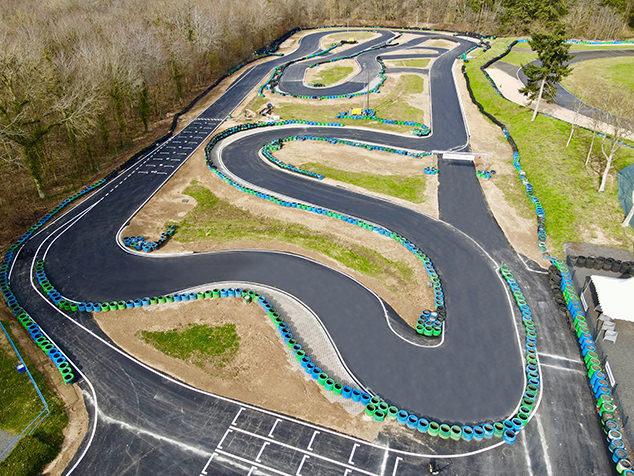Introduction: The Thrill of Pro Kart Racing
In the world of motorsport, where speed and skill converge on asphalt and dirt alike, one discipline stands out for its accessibility and exhilarating challenge: pro kart racing. Often seen as the gateway to higher levels of racing, this electrifying sport combines precision driving with strategic finesse, inviting enthusiasts from all walks of life to embrace the adrenaline rush. With engines roaring and tires screeching, pro kart racing has evolved into a competitive arena where both seasoned racers and budding talents can test their mettle, refining their techniques in tight corners and long straights. As we delve into the captivating universe of pro kart racing, we explore its origins, the thrill of competition, and the community that fuels this vibrant scene, where every lap offers a new story waiting to unfold.
Table of Contents
- Exploring the Thrill of Pro Kart Racing
- Essential Gear for Aspiring Kart Racers
- Techniques for Mastering the Track
- Choosing the Right Circuit for Your Skills
- Q&A
- The Conclusion
Exploring the Thrill of Pro Kart Racing
Pro kart racing is not just a sport; it’s an adrenaline-pumping adventure that combines speed, precision, and strategy. These miniature racing machines deliver an unmatched experience as drivers maneuver through tight turns and high-speed straights. The thrill lies in the challenge of controlling a vehicle that feels as dynamic as a full-sized race car but with the added excitement of being closer to the ground. Many fans find themselves enamored by the distinct features that make kart racing exhilarating:
- Speed and Agility: Karts are designed for rapid acceleration and quick handling, making every race a test of skill.
- Accessibility: With various classes and age brackets, anyone can participate, making it a family-friendly sport.
- Community Spirit: The kart racing community fosters camaraderie among competitors, enhancing the overall experience.
The technology behind these karts is just as riveting as the racing itself. Innovations in design and engineering continue to shape the future of the sport, pushing boundaries on how karts perform on the track. Notably, the handling dynamics, tire composition, and engine specifications each play a vital role in a racer’s success. Here’s a glance at some essential components:
| Component | Description |
|---|---|
| Chassis | The frame that holds all the other components together, crucial for stability. |
| Engine | The powerhouse of the kart, varying from 2-stroke to 4-stroke varieties. |
| Tires | Specialty tires designed for grip and optimal performance on various tracks. |
Essential Gear for Aspiring Kart Racers
For those venturing into the thrilling world of kart racing, having the right equipment is paramount to both performance and safety. A solid foundation begins with a reliable racing kart; this is the heart of your racing experience. You’ll also want to invest in a safety suit made of fire-resistant material, along with a pair of gloves that provide grip and protection. Beyond these essentials, a good-quality helmet is a non-negotiable item that guarantees head safety while also offering a comfortable fit. These elements create the first layer of your racing armor, ensuring you’re geared up properly for the track.
Equally important are the accessories that enhance your racing experience and performance. A well-structured racing shoe not only provides support but also enables better pedal movement. Additionally, protect your body with neck braces and rib protectors to minimize the risk of injury during intense rides. For those looking to fine-tune their machine, keep handy some tools for maintenance and spare parts like tires and brakes. Remember, every little detail counts in getting ahead in the race, allowing you to focus on honing your skills while feeling secure in your setup.
| Essential Gear | Description |
|---|---|
| Racing Kart | Your primary vehicle for karting adventures. |
| Safety Suit | Fire-resistant bodysuit for protection. |
| Helmet | Critical for head protection and safety. |
| Racing Shoes | Designed for comfort and improved pedal control. |
Techniques for Mastering the Track
To excel in pro kart racing, mastering the right techniques is essential. One of the fundamental skills to develop is cornering. Efficient cornering can significantly reduce lap times. Focus on the following strategies:
- Apex Approach: Always aim for the ideal racing line, hitting the apex to maximize speed.
- Throttle Control: Modulate your throttle application; accelerate smoothly as you exit corners.
- Braking Techniques: Use late braking to gain an edge over competitors while maintaining your line.
In addition to cornering, understanding weight transfer can make a huge difference in handling. Proper weight distribution enhances traction during acceleration and braking. Keep these pointers in mind:
- Lean into Corners: Shift your weight towards the inside of the turn to improve grip.
- Feel the Kart: Pay attention to how your kart reacts; adjust your seating and driving position for balance.
- Practice Drifting: Occasionally practice controlled drifting to understand the kart’s limits and handling better.
Choosing the Right Circuit for Your Skills
Selecting the ideal circuit for your karting journey involves considering your current abilities and the challenges you wish to embrace. Different tracks offer varied experiences, and understanding this can significantly affect your performance and enjoyment. Here are some factors to consider when picking a circuit:
- Track Layout: Look for circuits with a mix of straights and curves to help build your driving skills.
- Surface Condition: Some tracks may have better grip; this can enhance your confidence.
- Complexity: Beginners might prefer simpler tracks to develop foundational skills, while advanced drivers can thrive on intricate designs.
- Environmental Conditions: Factor in weather and time of year, as these can impact track conditions and your driving experience.
To further assist in your decision-making, consider experimenting with a variety of circuits. Many facilities offer introductory sessions that allow you to try different layouts. Here’s a quick summary of potential track types based on skill level:
| Skill Level | Recommended Track Type | Key Features |
|---|---|---|
| Beginner | Short, Simple Layout | Fewer sharp turns, higher visibility |
| Intermediate | Mixed Complexity | Varied corners, moderate length |
| Advanced | Challenging Circuit | Technical sections, elevation changes |
Q&A
Q&A: The Fast Track to Understanding Pro Kart Racing
Q: What is pro kart racing?
A: Pro kart racing is a competitive motorsport that involves racing go-karts on outdoor and indoor tracks. Unlike recreational karting, pro kart racing features specialized karts designed for speed and precision, with events ranging from local club races to international championships.
Q: How does pro kart racing differ from amateur karting?
A: The primary difference lies in the level of competition and the equipment used. Pro kart racers utilize high-performance karts equipped with advanced engineering, while amateur karting often employs recreational go-karts. Pro racers also compete under strict regulations and guidelines established by organizations like the International Karting Commission.
Q: What age do pro kart racers typically start?
A: Many pro kart racers begin their journey as young as five or six years old, participating in cadet racing leagues. As they progress through various age categories and skill levels, some transition to professional racing in their teens, often around 15 or 16 years of age.
Q: What skills are essential for success in pro kart racing?
A: Successful pro kart racers must possess a combination of reflexes, strategic thinking, and physical fitness. Mastering racing techniques like cornering, braking, and throttle control is crucial. Additionally, effective communication with the racing team and adaptability to varying track conditions play significant roles in achieving success.
Q: What types of events are included in the pro kart racing calendar?
A: Pro karting events can include sprint races, endurance races, and championship series. Sprint races feature shorter distances with more focus on speed and quick thinking, while endurance races test a team’s strategy and stamina over long durations.
Q: Are there different classes of karts in pro kart racing?
A: Yes, pro kart racing features several classes, categorized by engine power, weight limits, and age groups. Classes may include types such as shifter karts, two-cycle engine karts, and electric karts, each bringing its own unique challenges and racing experience.
Q: What is the role of teams in pro kart racing?
A: Teams play a pivotal role in pro kart racing, providing support in areas such as kart setup, tire selection, and race strategy. A successful team often includes a driver, mechanics, and pit crew who work collaboratively to optimize performance during races.
Q: How can someone get involved in pro kart racing?
A: Aspiring racers can start by joining local karting clubs and participating in training sessions. Many facilities offer rental karts for beginners. Once comfortable, they may progress to competitive leagues or events and consider investing in personal equipment for more serious racing.
Q: What are some challenges faced by pro kart racers?
A: Pro kart racers encounter various challenges, including intense competition, the physical demands of racing, and the need for continuous improvement. Moreover, securing sponsorship and maintaining relationships within the motorsport community can be crucial in advancing their careers.
Q: What can fans expect from a pro kart racing event?
A: Fans can look forward to thrilling speeds, close racing, and nail-biting finishes at pro kart racing events. The atmosphere is often charged with excitement, as spectators witness skilled drivers navigate challenging circuits, showcasing their talent and teamwork.
Q: Is pro kart racing a stepping stone to other motorsport careers?
A: Absolutely! Many professional drivers start their careers in karting before moving on to higher levels of motorsport, such as car racing or open-wheel series. The skills and experience gained in pro kart racing serve as a solid foundation for future success in the motorsport world.
This Q&A aims to illuminate the dynamic world of pro kart racing, providing insights for both enthusiasts and newcomers alike. Whether you’re a driver at heart or a fan in the stands, the thrill of the race and the spirit of competition are sure to ignite your passion for this exhilarating sport.
The Conclusion
As the engines roar and the tires screech, the world of pro kart racing continues to captivate both participants and spectators alike. With its blend of precision, speed, and strategy, karting serves as a thrilling entry point for aspiring racers, while also providing veterans with a platform to showcase their skills in an ever-evolving sport. This high-octane arena is not merely about competition; it is a community where passion ignites on the track, forging friendships and rivalries alike.
So whether you’re a seasoned driver chasing the checkered flag or a newcomer drawn in by the electric atmosphere, pro kart racing offers a unique experience that fuels adrenaline and creativity. As we watch this dynamic sport grow, one thing remains clear: the roar of the engines is just the beginning of the stories yet to be written on the track. Embrace the challenge, cherish the moments, and remember that every race is a journey worth taking. See you on the track!



